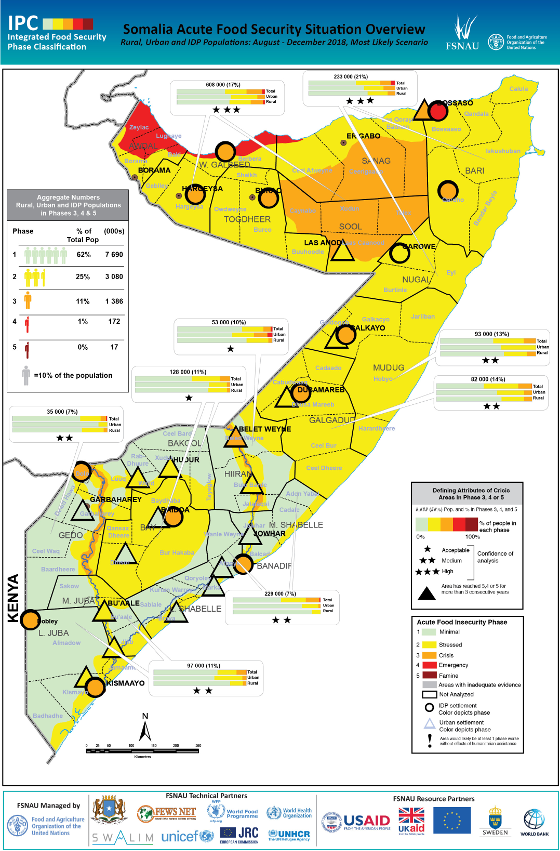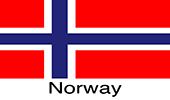FSNAU-FEWS NET 2018 Post Gu Technical Release - 02 Sep 2018
Issued: September 2, 2018
1.5 million people still face acute food security Crisis or worse in Somalia despite improvements
294 000 children are acutely malnourished
September 2, 2018, Mogadishu/Washington – Despite improvements, there are pressing humanitarian needs in Somalia according to findings from the post-Gu seasonal assessment conducted across Somalia in June and July 2018. Assessment results indicate food security has continued to improve due to average to above average rainfall between April and June that contributed to seasonal improvements to food and income sources and market conditions and the positive impacts of sustained and large-scale humanitarian assistance. Forecast average to above average Deyr (October-December 2018) rains, off-season harvest and favorable market conditions are expected to contribute to further improvements in the overall foods security condition between now and December 2018. However, acute food insecurity is prevalent among populations who lost most of their animals and who became destitute during the 2016-2017 severe drought, those affected by flooding in April and May 2018 and others who were affected by large-scale and protracted displacement due to a combination of conflict and natural hazards. These population groups are expected to face large food consumption gaps and need humanitarian assistance to prevent further deterioration of their food security and nutrition situation. This seasonal assessment was jointly led by the Food Security and Nutrition Analysis Unit for Somalia (FSNAU, a project managed by the Food and Agriculture Organization of the United Nations), and the Famine Early Warning Systems Network (FEWS NET, a project funded by USAID) and carried out with the active participation of Government institutions and other partners.
The 2018 Gu rains started early or on time and amounts were average to above average in most areas and slightly below average to near average in the northeast. Low-lying areas along Shabelle and Juba rivers and other depressed areas were affected by river and flash floods. 2018 Gu is the wettest season in nearly two decades; favorable rainfall during the 2018 Gu season has helped end drought conditions that persisted since 2016 Gu. Favorable rainfall has improved availability of pasture and water for livestock and normal livestock migration possibilities across most parts of the country. As a result, livestock production, herd sizes and milk availability have also improved. Food access among pastoralists in many areas improved in the first half of 2018 due to increased terms of trade between livestock and cereals. However, the adverse impacts of the 2016-2017 severe drought persist, especially among pastoralists who lost most of their animals and among people who became destitute and were displaced.
In southern Somalia the 2018 Gu season cereal production is estimated at 147 200 tonnes, including 7 200 tonnes off-season harvest expected in October. This level of production is 17 percent higher than the long-term average (1995-2017) and 58 percent more than the five-year average (2013-17). The 2017 Gu/Karan cereal production in northwest, expected to be harvested in November, has been affected by erratic rainfall and is estimated at 19 000 tonnes, which is 58 percent lower than the average for 2010-17. Poor households in the crop-dependent Northwest Agropastoral livelihood zone and some parts of southern Somalia (mainly riverine) currently have little or no food stocks and limited farm labor opportunities due to low production and the extended lean season.
Data from OCHA indicates that the current total population of IDPs across Somalia is 2.6 million. Most of the 13 main settlements for Internally Displaced Persons (IDPs) have been classified as Crisis (IPC Phase 3). Bossasso IDP settlement that has experienced extreme food security and nutrition outcomes has been classified as Emergency (IPC Phase 4). Most rural and urban parts of Somalia are currently in Stressed (IPC Phase 2) or Minimal (IPC Phase 1), partly due to sustained humanitarian intervention that contributed to improved food security and nutrition outcomes. According to the Somalia Food Security Cluster, emergency humanitarian assistance reached 1.9 million people a month between February and July 2018.
A recent forecast issued by the Greater Horn of Africa Climate Outlook Forum (GHACOF50), indicates a greater likelihood of normal to above normal 2018 Deyr (October-December) rains across Somalia. As a result, pasture and water availability, crop cultivation, livestock reproduction, access to agricultural employment, water and food prices are expected to continue to improve through late 2018. However, the expected average to above average rains may also cause flooding in some low-lying and riverine areas.
In the absence of humanitarian assistance, food security outcomes are expected to deteriorate to Emergency (IPC Phase 4) in Guban Pastoral livelihood zone and to Crisis (JPC Phase 3) in Northern Inland Pastoral of Sool and Sanaag regions. In summary, over 1.5 million people will face Crisis or worse (IPC Phases 3 or higher)1 between now and December 2018 which represents a significant improvement in the overall food security situation in Somalia compared to the 2.7 million people projected to be in Crisis (IPC Phase 3) or worse between February and June 2018. Through December 2018, an additional 3.1 million people are classified as Stressed (IPC Phase 2), which brings the total number of people facing acute food insecurity across Somalia to 4.6 million.
Results from 30 separate nutrition surveys conducted by FSNAU and partners between in June and July 2018 indicate that the overall nutrition situation in Somalia has continued to improve due to a combination of improved food security conditions, reduced outbreak of diseases and sustained humanitarian interventions. However, high level of acute malnutrition tends to persist in several population groups due to underlying/structural causes. The overall, level of acute malnutrition at national level has improved to Serious (5-9.9% Global Acute Malnutrition-GAM) in the current 2018 Gu 2018 (median GAM of 14.0%) from Critical in 2017 Gu (median GAM of 17.4%). There are no improvement in the overall current acute malnutrition prevalence compared to 2017/18 Deyr (median GAM of 13.8%). GAM prevalence is Critical (15-29.9%) in 12 out of 33 populations surveyed. Severe Acute Malnutrition (SAM) prevalence is Critical (≥4-5.6) only among Mogadishu Internally Displaced Persons (IDP) settlement and in Guban pastoral livelihood. Crude Death Rate (CDR) is Critical (1 to <2/10 000/day) in 3 out of 33 population groups surveyed. Morbidity rates remain high (>20 %) in many parts of the country. Accordingly, between August and December 2018 an estimated 294 200 children will likely face acute malnutrition, including 55 200 who are likely to be severely malnourished (total acute malnutrition burden).
Most of the 13 main IDP settlements are classified as Crisis (IPC Phase 3) between now and the end of 2018. Declining food prices and increased employment opportunities have improved food security situation in most urban areas, including those that have experienced trade disruptions due to insecurity. However, some urban areas in the north and southern Somalia affected by depreciation of the local currency and flooding are classified as Crisis (IPC Phase 3).
Urgent treatment and nutrition support is needed for approximately 294 200 acutely malnourished children, including 55 200 who severely malnourished between now and December 2018. Integrated support interventions should be sustained to maintain recent improvements as well as prevent further deterioration in the nutrition situation. Over 1.5 million people facing acute food security Crisis (IPC Phase 3) or worse need urgent humanitarian assistance and livelihood support between now and December 2018. Livelihood support is also required for 3.1 million people who are Stressed (IPC Phase 2)
Areas and Populations of Concern
Populations groups classified as Crisis (IPC Phase) or worse require interventions aimed at reducing food consumption gaps, reducing acute malnutrition, saving lives and protecting and saving livelihoods.
Regions of Somalia | Total Population (2014 Estimates) | Number of Acutely Food Insecure People (August-December 2018) | |||
Stressed (IPC 2) | Crisis (IPC 3) | Emergency (IPC 4) | Catastrophe (IPC 5) | ||
Awdal | 673,264 | 149,000 | 121,000 | 36,000 | - |
Woqooyi Galbeed | 1,242,003 | 401,000 | 152,000 | 17,000 | 6,000 (Hargeisa IDPs) |
Togdheer | 721,363 | 218,000 | 49,000 | 6,000 | 3,000 (Burao IDPs) |
Sanaag | 544,123 | 140,000 | 86,000 | 1,000 | - |
Sool | 327,427 | 80,000 | 134,000 | - | - |
Bari | 730,147 | 168,000 | 170,000 | 32,000 | 1,000 (Bossasso IDPs) |
Nugaal | 392,698 | 105,000 | 30,000 | - | - |
Mudug | 717,862 | 227,000 | 93,000 | - | - |
Galgaduud | 569,434 | 203,000 | 81,000 | 1,000 | - |
Hiraan | 520,686 | 114,000 | 41,000 | 11,000 | 2,000 (Beletweyne IDPs & Urban) |
Middle Shabelle | 516,035 | 68,000 | 6,000 | - | - |
Lower Shabelle | 1,202,219 | 123,000 | - | - | - |
Banadir | 1,650,228 | 456,000 | 189,000 | 30,000 | 5,000 (Mogadishu IDPs) |
Bay | 792,182.0 | 261,000 | 101,000 | 7,000 | - |
Bakool | 367,227 | 81,000 | 20,000 | - | - |
Gedo | 508,403 | 109,000 | 30,000 | 5,000 | - |
Middle Juba | 362,921 | 93,000 | 9,000 | - | - |
Lower Juba | 489,307 | 80,000 | 77,000 | 11,000 | - |
TOTAL | 12,327,529 | 3,077,000 | 1,388,000 | 157,000 | 17,000 |
The following populations considered hotspots in need of urgent nutrition and health support interventions. They have Critical prevalence of acute malnutrition (≥15% GAM) or 10.7 percent or more of children have Mid-Upper Arm Circumference (MUAC) below the 125 millimeters (mm) threshold:
-
Rural Livelihoods: Northern Inland Pastoral of Northeast, Hawd Pastoral of Northeast, Northwest Guban Pastoral, North Gedo Riverine , Beletweyne District (Reverine & Agro-pastoral), South Gedo Agro-pastoral, South Gedo Riverine, Mataban, Jalalaqsi and Bulobute districts of Hiran Region, Juba Riverine
-
IDP Populations: Bosaaso, Garowe, Galkacyo; Qardho, Mogadishu; Baidoa, Kismayo and Dolow
FSNAU and FEWS NET will continue to monitor conditions and outcomes and report on the situation. All information will be made available through www.fsnau.org and www.fews.net.
For more information, please contact: Nancy McNally, Communications Officer, Tel: +254 -739469107, Email: nancy.mcnally@fao.org and Marie Maroun, Communications officer, Famine Early Warning Systems Network (FEWS NET), Tel: +1 202 524 7749, Email: mmaroun@fews.net
1 The Integrated Food Security Phase Classification (IPC) is a set of tools and procedures to classify the severity of food insecurity using a widely accepted five-phase scale. At the area level, it divides areas into the following phases: IPC Phase 1=Minimal; Phase 2=Stressed; Phase 3=Crisis; Phase 4=Emergency; and Phase 5=Famine.



















